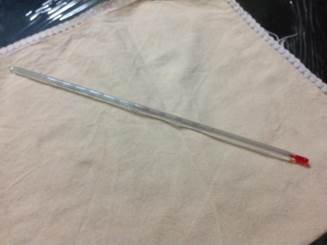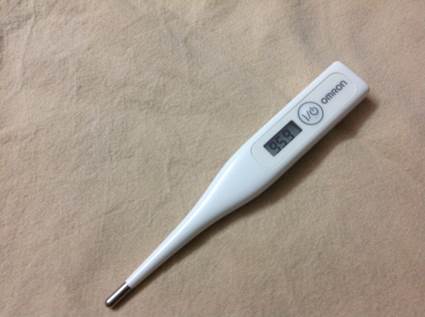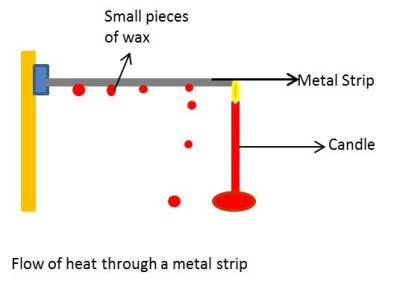Notes of chapter: Heat are presented below. Indepth notes along with worksheets and NCERT Solutions for Class 7.
(1) Heat-
Heat is transfer of energy from hotter body to colder body.
(2) We cannot always rely on our sense of touch to decide whether an object is hot or cold.
Experiment to show feeling water of different temperature-
Take three large mugs A, B and C. Put cold water in mug A and hot water in mug B. Mix some cold and hot water in mug C. Now, dip your left hand in mug A and right hand in mug B for 2-3 minutes. Put both the hands in the mug C. After few minutes our left hand felt clod while our right hand felt hot. But, we don’t know exact coldness and hotness of our hand.

(3)Temperature is a reliable measure of the hotness of an object.
(4) Temperature is measured by a device called thermometer.
(5) A clinical thermometer is a thermometer which measures our body temperature.

Clinical Thermometer
(i) A clinical thermometer consists of a long, narrow, uniform glass tube.
(ii) It has a bulb at one end. This bulb contains mercury.
(iii) Outside the bulb, a small shining thread of mercury can be seen. If you do not see the mercury thread rotate the thermometer a it till you see it.
(iv) A clinical thermometer reads temperature from 350C to 420C.
(6) Precautions to be observed while reading a clinical thermometer
(i) Thermometer should be washed before and after use, preferably with an antiseptic solution.
(ii) Ensure that before use the mercury level is below 350C.
(iii) Read the thermometer keeping the level of mercury along the line of sight.
(iv) Handle the thermometer with care. If it hits against some hard object, it can break.
(v) Don’t hold the thermometer by the bulb while reading it.
(7)Reading a thermometer-
(i) Ensure that before use the mercury level is below 350C. If temperature is not below 350C give thermometer a few jerks. The jerks will bring down the level of mercury below 350C.
(ii) Place the thermometer under the tongue. Remove thermometer after one minute. Result is our body temperature.
(iii) Don’t hold the thermometer by the bulb while reading it.
(iv) Read the temperature:-
(a)Note the temperature difference indicated between the two bigger marks. Bigger lines indicate 1 degree.
(b)Note the number of divisions by small marks between these bigger marks. Small lines between two bigger marks are 10.
Therefore, one small line indicates 0.1 degree.
(8) The normal temperature of human body is 370c or 98.60F.
(9) Normal temperature is the average body temperature of a large number of healthy persons. So, it could be slightly higher or slightly lower for different people.
Body temperature in different persons
(10) The clinical thermometer is designed to measure the temperature of human body only.
(11) The clinical thermometer has the range from 35oc to 420c because human body temperature cannot go below 350c or above 420c.
(12) Laboratory thermometers are used to measure temperatures of samples provided in labs.

Laboratory Thermometer
(13) Laboratory thermometers are made of glass.
(14) The range of a laboratory thermometer is generally from -100C to 1100C. But it can vary between models.
(15) Precautions to be observed while reading a laboratory thermometer.
(i) It should be kept upright.

Measuring of temperature from laboratory thermometer
(ii)The bulb should be surrounded from all sides by the substance of which the temperature is to be measured. If you take out thermometer from the water mercury starts falling.
Experiment showing laboratory thermometer should be surrounded by the liquid-
Take some hot water. Dip the bulb of the laboratory thermometer in the water. Note its temperature. Now, take out the thermometer from the beaker. Observe the level of mercury. It starts to fall. Therefore we should note the temperature when the bulb is in water.
(iii)The bulb should not touch the surface of the container.
(16) Reading a lab thermometer-
(i) Note the temperature difference indicated between the two bigger marks. Bigger lines indicate 10 degree.
(ii) Note the number of divisions by small marks between these bigger marks. Small lines between two bigger marks are 10.
Therefore, one small line indicates 1 degree.
(17) Mercury does not fall or rise in a clinical thermometer when we taken out it from the mouth because the thermometer has kink near the bulb. This kink prevents mercury level from falling on its own.

(18) Mercury is a toxic substance and is very difficult to dispose of if a thermometer breaks. Now days, digital thermometers are available which do not use mercury.

Digital thermometer
(19) The process by which heat is transferred from the hotter end to the cooler end of an object is known as conduction. In solids, generally, heat is transferred by the process of conduction.
Eg:- A frying pan becomes hot when kept on a flame. When the pan is removed from the flame, it slowly cools down.
Experiment showing conduction in solids-
Take metal rod and fix some small pieces of wax at equal distance on it. Clamp the rod from one side and heat it from other end. The wax pieces started to fall from the end near to flame. It shows that heat is transferred from the end nearest to the flame to the other end.

(20) Conductors of heat are those materials which allow the heat to pass through them easily.
Eg :- Metals
(21) Insulators of heat are those materials which do not allow heat to pass through them easily.
Eg :- Plastic, wood etc.
Results of articles after putting them in hot water
(22) The convection is a mode of transferring heat through liquid and gases by molecular motion.
(i)The convection in liquid – The process of heat transfer by the movement of molecules of liquid, is known as convection.
Experiment showing convection in liquids-
Take a round bottom flask. Fill it two third with water. Place it on stand. Put some potassium permanganate when water in flask is still. Heat the flask with candle just below the crystal. When water is heated, the water near the flame gets hot. Hot water rises up. The cold water from the sides of flask moves down towards the source of heat.This water also gets hot and rises and water from the sides moves down. This water continues till the whole water gets heated. Movement of water can be seen by colour of potassium permanganate which shows convection in liquids.


Convection In Liquids
(ii) The convection in gases (air)- The process of heat transfer by the movement of molecules of gases, is known as convection.
Experiment showing convection in gases-
Light a candle and put your one hand on the candle and other hand on the side of the flame. Towards the top, the air gets heated by convection. Therefore, the hand above the candle feels hot. It shows convection in gases.

Convention in gases
(23) Sea breeze is the cool air above the sea which moves towards the land to replace the hot air above the land.

(24) Land breeze is the cool air above the land which moves towards the sea to replace the hot air above the sea.

(25) Radiation is a process of heat transferring with or without medium from hotter source to cooler source.
Eg:-
(i) Heat from sun comes to us.
(ii) Heat from room heater.
(26) Black colour or dark colour absorbs more heat than white or light colours.
Experiment showing black colour absorbs more heat than white colour-
Take two identical cans. Paint the outer surface of one black and the other white. Keep them in sun for about one hour. Measure the temperature of both the cans. The temperature of black colour painted can is higher than the white colour painted can. It happened because black colour painted can absorbs more heat than white colour painted can.
(27) White colour or light colour transmits more heat than black colour or dark colour.
Experiment showing white colour transmit more colour than black colour-
Take two identical cans. Paint the outer surface of one black and the other with white colour. Fill them with hot water. Leave them in a room. After some time the temperature of white can is cooler than the black can. It happened because the white colour transmitted more heat than black colour.
(28) Woollen clothes keep us warm in winter because wool is a poor conductor of heat. There is air trapped in between the wool fibers. This air prevents the flow of heat from our body to the cold surroundings.
(29) Two thin blankets in winter are warmer than one thick blanket because air is trapped in between the layers of two blankets. This air prevents the flow of heat from our body to the cold surroundings.
Helping Topics